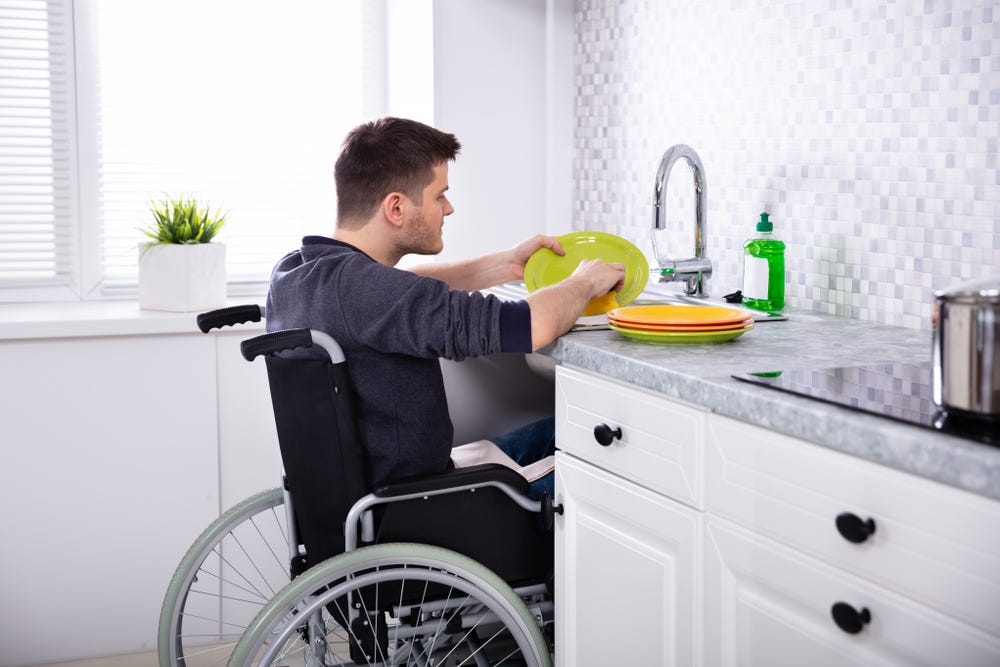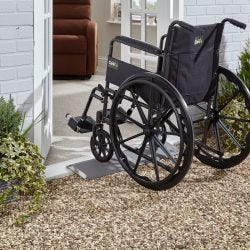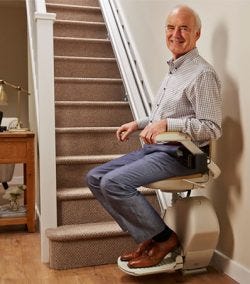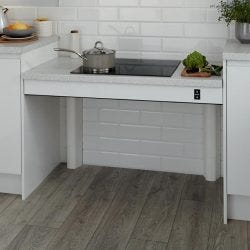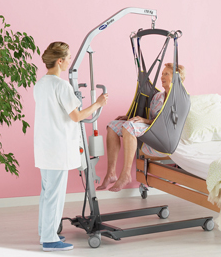Home Adaptations
Most new homes are built with accessibility in mind, with 33 inch wide doors and level thresholds becoming more common in new-builds, but for older homes it can be a challenge to make a home fully accessible to wheelchairs and powerchairs. Here we run through some of the changes that you can make and the practicalities of carrying out the work.
Create Level Thresholds
One of the biggest challenges to getting out in a wheelchair is that first step, literally. If your front door steps down to the path you could install some clever threshold ramps, but most modern PVC front doors have a frame that also needs to be climbed over. The best solution is to replace the front door with a level threshold door, which does away with the lower part of the door frame. These doors are just as secure with multipoint locking. Once your new door is installed you just need to create a gentle slope from the door to the path. The more space you have, the gentler the slope can be. As well as the front door, back doors and patio doors should all also have level thresholds.
Wider Doorways
As mentioned, many new builds come with 33 inch (84cm) internal doors which provides plenty of room for a wheelchair (e.g. Tuni Vision is 63cm wide, and even the CareCo Explorer Heavy Duty wheelchair will fit through, being 80cm wide. While most internal doorways can be made wider, the way the house is constructed will make a huge difference in cost and disruption. If your internal walls are stud walls then you are in luck - a builder will just need to remove the door frame and some plasterboard, and move the stud supports before making everything good again, and hanging a new door. However, if your walls are solid brick, which is common in older homes, the task will be much harder for your builder, and much messier. Breaking tools and angle grinders will likely be required which will produce huge amounts of dust, so care will be needed as well as a bigger clean up job afterwards. Many people chose to do away with internal doors to make access easier. While you should keep some, such as kitchen doors for fire safety, sometimes it is easier not to bother with doors to dining area and living rooms.
Install a Stair Lift
Stair lifts are one of the first home mobility aids that come to mind for most people, probably thanks to the TV adverts. Stair lifts can be installed into most homes, even homes with curved staircases. Acorn Stairlifts are manufacturers in the UK and meet the highest safety standards. The Acorn 130 Stairlift is best for straight stairs and because it fits to the stairs rather than the wall causes less disruption to your home and decoration. If you ave curved stairs or stairs that have 90 degree turns, they the Acorn 180 Stairlift is needed. Stairlifts do not take time to install and can be up and running within a day. Most should come with battery back up so they continue to work in the event of a power cut. One important consideration is the transfer from the stair lift to a wheelchair. Support bars may be needed to help a wheelchair user to move themselves from the stair lift into their wheelchair. As well as these, you need to check there is room for both stairlift and wheelchair, so the landing may need to be widened to accommodate both. Also, having a dedicated upstairs wheelchair make life much easier.
Low Worktops and Sinks
Wheelchair users often find it very difficult to use kitchen sinks and worktops, so lowering a worktop area and providing a lower, floating kitchen sink with a recess below to allow wheelchair user to get close is vital. Many kitchen suppliers now offer motorised rise and fall kitchen sinks, hobs and worktops, which are perfect when wheelchair users are living with non-wheelchair users - pictured is a solution from Howdens. Whether or not you make changes to your kitchen worktops, having a handy perching stool by worktops is always a good idea - they take the weight off your feet while you prepare a meal or wash up.
Bathroom Modifications
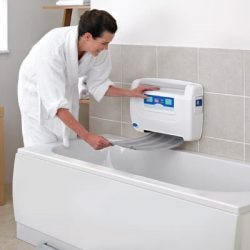
Like a kitchen, a bathroom should be modified for wheelchair users with an easy to access sink. Other changes needed include walk in / roll in showers, bath lifts, and toilet support in the form of seat raisers, toilet frames, grab bars and stools. The CareCo Aquabathe Bath Lift is a wall mounted bath lift that does not reduce the space available in the bath like many other lifts do. Because it is weight bearing it will need to be securely fixed to the wall, so be sure to attach to vertical studs or support on a solid wall.
Bedrooms
 An adjustable bed is usually all that is required, so no major renovation as such. If you are modifying a home for a wheelchair user, the bed mattress should ideally the same height as the wheelchair seat for the easiest independent transfer. Electric adjustable beds can be lowered and raised for easy access and inclined to more comfortable positions. There is the option of installing a standard adjustable bed, or if required, a profiling bed that provides more support and is similar to a hospital bed. If the bedroom has a nice view it may be a nice idea to lower the window level or even add a Juliet balcony for wheelchair users so they can enjoy the view from the comfort of a wheelchair.
An adjustable bed is usually all that is required, so no major renovation as such. If you are modifying a home for a wheelchair user, the bed mattress should ideally the same height as the wheelchair seat for the easiest independent transfer. Electric adjustable beds can be lowered and raised for easy access and inclined to more comfortable positions. There is the option of installing a standard adjustable bed, or if required, a profiling bed that provides more support and is similar to a hospital bed. If the bedroom has a nice view it may be a nice idea to lower the window level or even add a Juliet balcony for wheelchair users so they can enjoy the view from the comfort of a wheelchair.
For people that are very disabled, hoists are a good idea. Hoists are used to transfer a person from a wheelchair to a bed, chair or into a bath. A hoist system that runs all the way through a home can be a great benefit to a disabled person, as it reduces the number of transfers. For instance, you can be carried from bed straight into the bath without the need to be moved into a wheelchair first. Most mobile hoists fit through all doorways, for examples, the Invacare Birdie Compact Hoist is just 55cm wide (22 inches).
Smart Home Technology
Other suggested changes include lowering light switches, and also adding extra switches to operate lamps from the main switch. Installing electric curtains and blinds, and even better, use smart internet technology to control lights and curtains from a mobile phone. Video doorbells are also very useful - there is nothing more annoying than getting to a door after the person ringing the bell has already walked off. A wireless video door phone allows you to talk to somebody at your door without leaving the comfort of your seat, so you can find out if it's a friend visiting or that package you ordered from Amazon, or just another cold caller.
Don't Pay VAT
If you are modifying a home for a disabled person you will not have to pay VAT, so long as you sign a declaration. However, most traders and bathroom fitters do not know about this, so you'll need to convince them first. There is more information on the Government website.
Government Grants are Available
It may be possible to get a Government grant to help with modifying a home for a person with a disability. Up to £30,000 is available, subject to terms and conditions. If you work or have savings, this figure will likely be less. You can find out more information on the Government website here: https://www.gov.uk/disabled-facilities-grants.
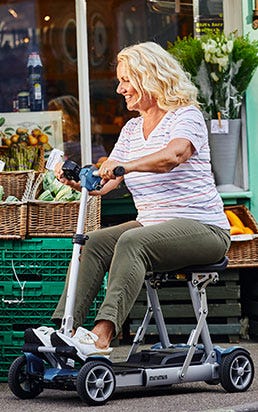

 Price Match Promise
Price Match Promise
 Next day delivery, 7 days a week
Next day delivery, 7 days a week
 Nationwide Showrooms
Nationwide Showrooms
 Rated Excellent
Rated Excellent
